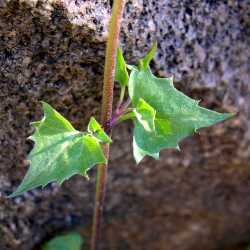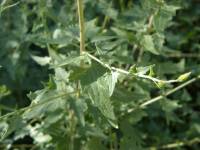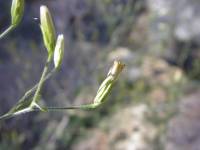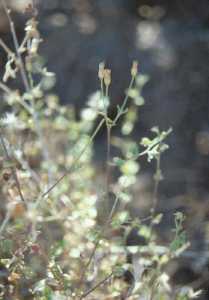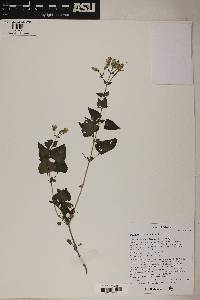- Home
- Search
- Images
- Datasets
- Sample Use
- How to Cite
- Additional Information
- About NEON
- NEON Data Portal
- ASU Biocollections
- About Symbiota
|
|
|
|
Family: Asteraceae
Coulter's brickellbush
|
Shrubs, 30-150 cm. Stems much branched from bases, pubescent, often gland-dotted. Leaves opposite; petioles 4-12 mm; blades 3-nerved from bases, broadly ovate to deltate, 10-60 × 10-30 mm, bases truncate, has-tate, or subcordate, margins usually toothed (1-3 sets of sharp teeth near bases), rarely subentire, apices attenuate, faces minutely pubescent. Heads in loose, paniculiform arrays. Peduncles 5-40 mm, pubescent and sometimes gland-dotted. Involucres cylindric to campanulate, 8-12 mm. Phyllaries 17-22 in 4-6 series, greenish, often purple-tinged, 4-5-striate, unequal, margins scarious (apices acute to acuminate or mucronate, minutely pubescent); outer lance-ovate to narrowly lanceolate (glabrous or sparsely pubescent), inner narrowly lanceolate to linear (glabrous). Florets 13-25; corollas pale yellow-green, often purple-tinged, 7-8.2 mm. Cypselae 3-5 mm, hispidulous, strigose, or glandular-pubescent; pappi of 28-40 smooth or barbellulate bristles. FNA 2006, Wiggins 1964, Benson and Darrow 1981 Common Name: Coulter's brickellbush Duration: Perennial Nativity: Native Lifeform: Subshrub General: Shrub, 30-150 cm tall; stems much branched from base; branches opposite, ascending- spreading, pubescent with yellow-gray hairs, often gland-dotted. Leaves: Opposite, on petioles 4-12 mm long; blades deltoid to rhombic-ovate, 1-6 cm long by 1-3 cm wide, 3-nerved from base, margins with 1-3 sets of sharp teeth, usually near the base, the bases truncate, hastate, or subcordate, the apices actute, and the faces sparsely puberulent. Flowers: Flower heads discoid, arranged in loose panicles, the peduncles 5-40 mm long, pubesent and sometimes gland-dotted; involucre (ring of bracts wrapped around the flower head) cylindric to campanulate 8-12 mm, the bracts (phyllaries) 17-22 in 4-6 series, narrowly lanceolate to linear, 4-5 striate, unequal, greenish, often purple-tinged, with scarious margins; florets 13-25, all discs, the corollas 8 mm long, yellow-green or purple tinged. Fruits: Achenes 3-5 mm, hispidulous, yellow-brown to yellow-gray, topped with a pappus of 28-40 smooth to barbellulate bristles. Ecology: Found on arid and rocky slopes, from 2,000-4,000 ft (610-1219 m); flowers September-May. Distribution: AZ, s NM, sw TX; south to c MEX. Notes: Brickellia is a genus of shrubs and perennial herbs with all disc flowers, these usually white to cream colored; flower heads wrapped in several rows of bracts (phyllaries), the outer rows shorter than the inner rows; and 10-nerved seeds topped with white tufts of bristles. B. coulteri is a fragrant shrub, very brittle in appearance, with somewhat more delicate branches and inflorescences than other shrubby Brickellias; the leaves are small, usually less than 4 cm long, opposite, and triangular-ovate with 1-3 pairs of enlarged, sharp teeth at the base; flower heads are clustered or solitary, on short peduncles less than 4 cm long. B. atractyloides also has leaves with sharply toothed edges, but in that species the leaves are usually alternate and the teeth are not concentrated near the bottom of the leaves. Ethnobotany: Unknown, but other species in this genus have uses. Etymology: Brickellia is named for Dr. John Brickell (1749-1809), a botanist and physician who worked in Georgia; coulteri is named for Dr. Thomas Coulter (1793-1843), the first botanist to collect in Arizona. Synonyms: None Editor: SBuckley 2010, FSCoburn 2015, AHazelton 2015 |




